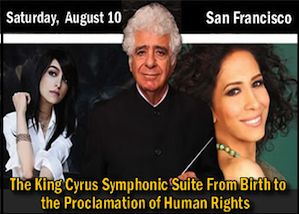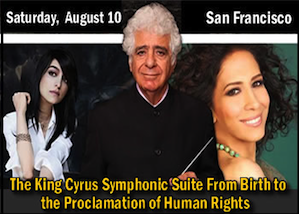
Couldn't make it to the Masonic Auditorium performance of Loris Tjeknavorian's King Cyrus Symphonic Suite on Saturday, but received an extensive report on the concert from Dianna Ch'an-Moriwaki; here are excerpts from it, with thanks to the writer:
[The Suite] features a speaker as the primary soloist, telling Cyrus’ story as a narration, knitting the three movements and their subsections into a seamless whole. Houshang Touzie, of Iran and then America since 1979, an established playwright, actor, and director in film, television, and theater, was the narrator, of text by Zareh Tjeknavorian, based on Herodotus and Xenophon.A harp accompanies the opening narration, and the intervals in the music and the harp’s timbre eloquently set the time and place: an archaic era, an Eastern locale. That established, each narration thereafter is accompanied only by the contrabass, playing one note only, quietly but steadily, somewhat like a drone, appropriately solemn, quietly dramatic, and extremely effective in maintaining the mood. As the King of Persia, Touzie’s narration was contained and tempered, appropriate to the dignity and humanity of a great monarch. There were no histrionics, Touzie’s narration instead conveying Cyrus as a seasoned, intelligent man of wisdom who possessed mastery in mature self-control.
Tjeknavorian favors the use of seconds in his harmonic structure, and it not only conveys emotional searching and suffering, but also maintains a subtle current of tension throughout, waxing or waning as the text determines. His themes are frequently written with secondary voices as "echoes," a characteristic of much Middle Eastern and Asian music, but he juxtaposes them in different time values and structures following or leading, such that many of these instances are like canons or seem contrapuntal, quite beguiling and marvelous in their juxtaposed dissonances. The fight scenes are not clichéd as one hears in film music, but refreshingly, are very original in imagination.
The orchestral sections are the major proportion of the entire work, this full-length work being a revision which expands the original, written in 1972. This is orchestral writing ingenious in producing its stunning effects and color, among which were the ominous, whirring fury; sharp, stabbing shafts and points; musical noises that punctuate and accompany the vocal section, in particular, what sounded like the snapping of a huge rubber band.
For a 77-piece ensemble, this orchestra included a large percussion battery, and yet, there was nothing at all hackneyed or exhibitionistic in the score, nothing in the least that suggested "Hollywood," nothing that was stereotypically "Oriental," no gratuitous percussion coloristics. Every instrumental and section effect, texture, timbre, all was well judged, relevant and germane, and, musically speaking, in good taste.
This is music which is not off-putting on first hearing, will not wear thin over time due to cheap, vernacular tricks up the orchestrator’s sleeve. Rather, this is the composition of a master composer totally in his element. King Cyrus Symphonic Suite is a symphony-length, three-movement work of major significance, and should be recorded, should be programmed by major symphonies. It is not ground-breaking, innovative, trail-blazing music, nor does music need to be, in the first place. Rather, King Cyrus is original, imaginative, with a uniquely individual stamp. It could add richly to the catalogue of important and worthy contemporary classical works.

